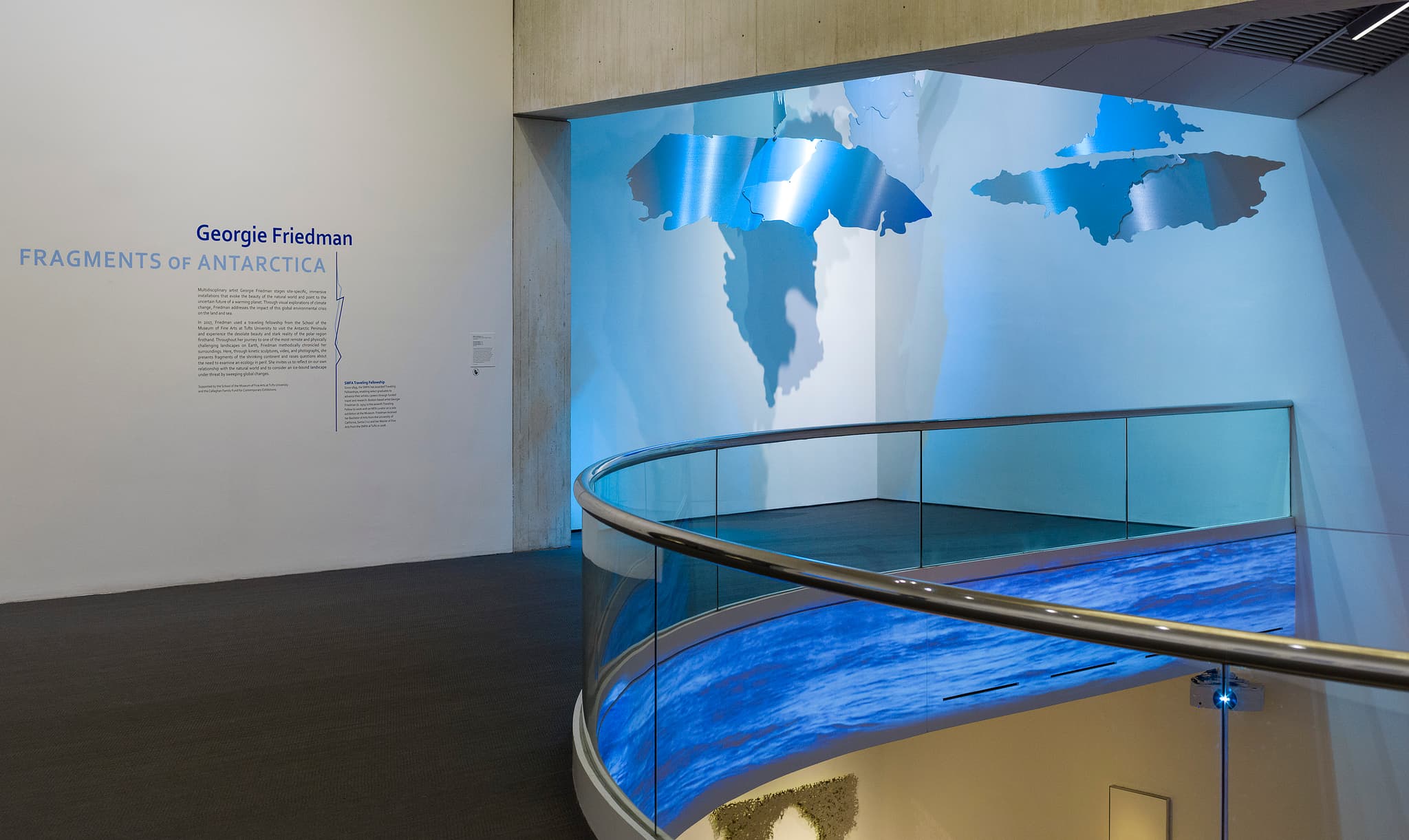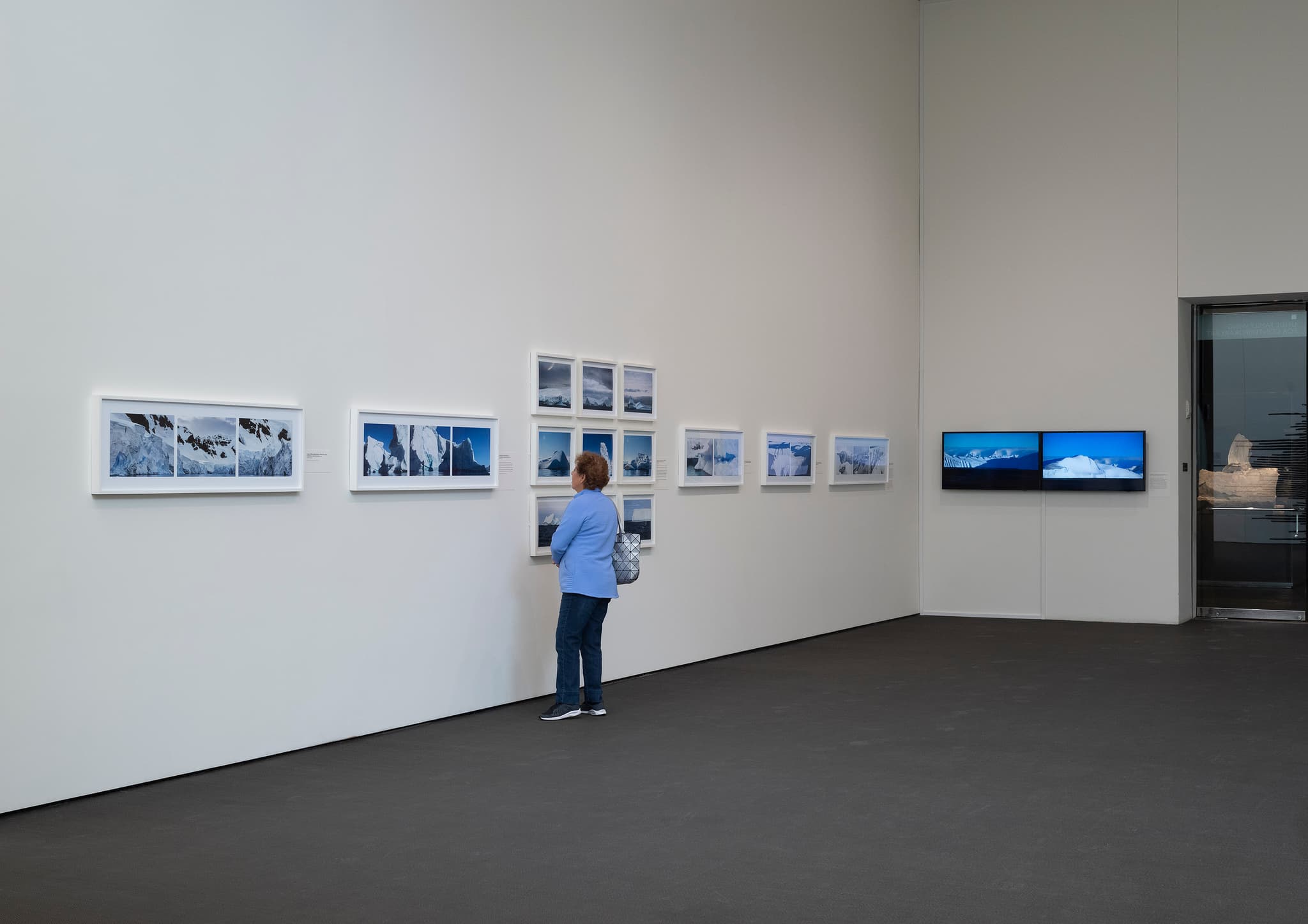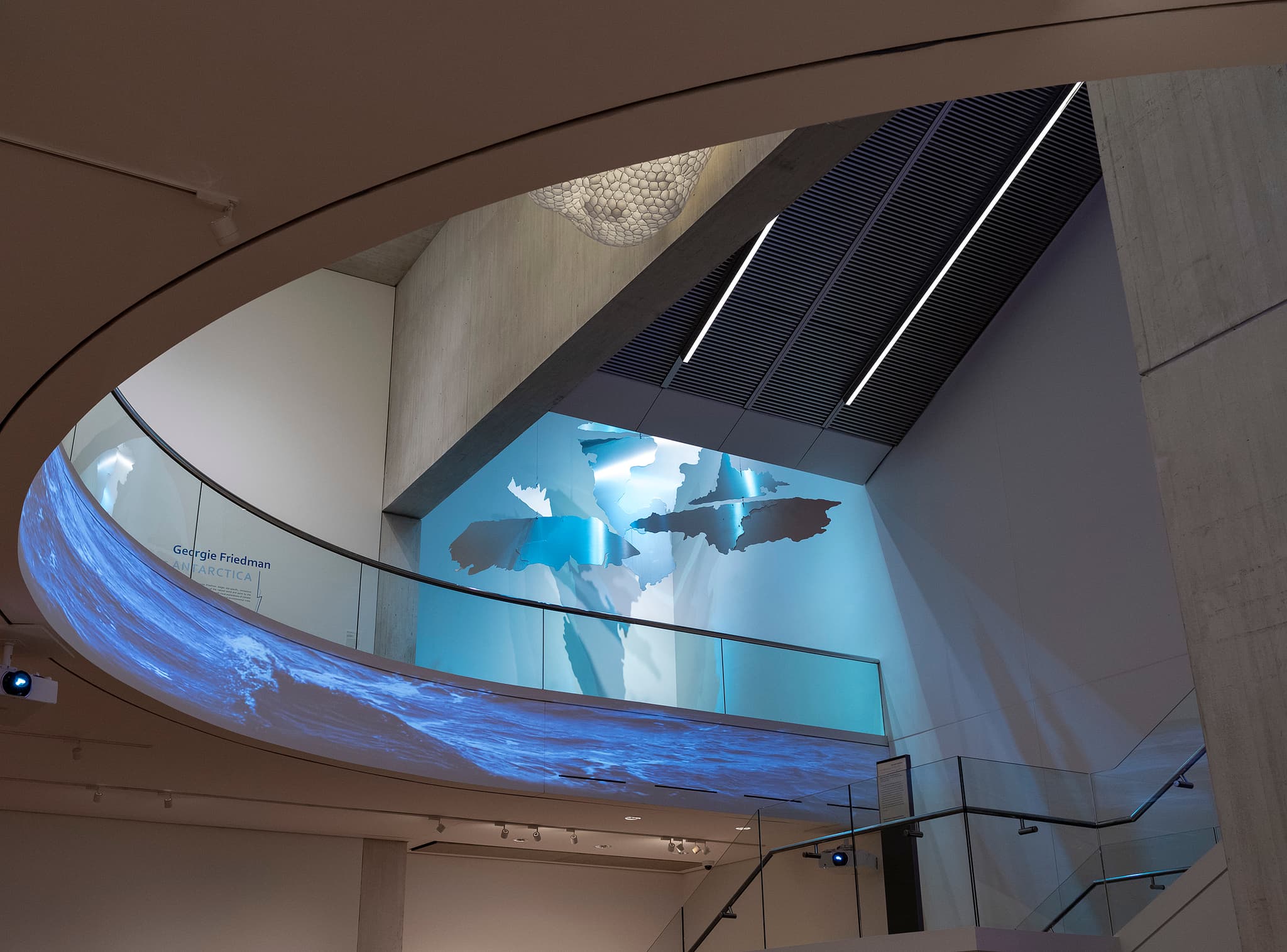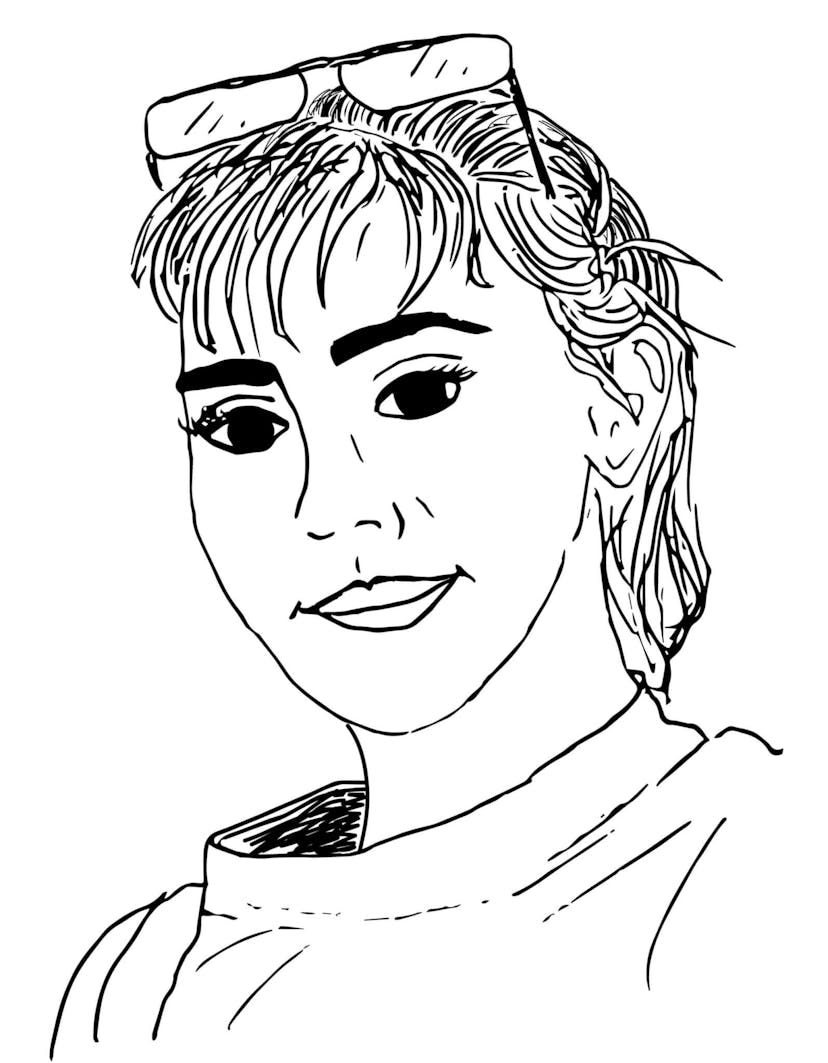In her current exhibition at the Museum of Fine Arts, Boston, “Fragments of Antarctica,” multidisciplinary artist Georgie Friedman shares an expanded view of one of the most untouched parts of the world. Known for her site-specific video installations, The Boston-based artist makes work that probes the relationship between natural phenomena and human fragility, exploring the emergent psychological, societal, and power relationships between human and environmental forces. In her most recent installation, it becomes impossible to ignore our planet’s climate crisis while immersed in a striking view of what remains of Antarctica’s icebergs.
Ten years after receiving her graduate degree from the School of the Museum of Fine Arts, Friedman was awarded a Traveling Fellowship from her alma mater in 2017 to spent two weeks in the Antarctic Peninsula. During this time, the work for “Fragments of Antarctica” emerged. Located on the second level of the MFA’s Contemporary Linde Family Wing, the exhibition acts as an immersive installation, complete with video, photography, and kinetic-sculpture elements. The exhibition space evokes the kind of quiet admiration typically reserved for cinematic nature documentaries. Drenched in blue and white hues, the exhibition is rich with textures and colors from the natural compositions and phenomena that Friedman has so keenly captured and manipulated. Her work provides varying vantage points through which to view the Antarctic landscape: from panoramic photographs to deeply textured sculptures. Presented together, one realizes their own trivial scale in relation to these gigantic icebergs and the infinitely deep and spanning seas. All the while, the looming effects of global warming, erratic weather activity, and sea level rise are present in every corner of her work.
Friedman and I sat down together to discuss the details of her journey, her research practice, experiential art, and her philosophy on art and environmental activism. She is someone who speaks quickly and urgently, generously tending to my questions while jumping around to exciting anecdotes. The following is an edited transcription of our conversation.
GL: There are obviously many components to “Fragments of Antarctica”—photographs, video, and an immersive installation all presented together. How did these elements develop from your time in Antarctica to the installation here at the MFA?
GF: During my visit at the Antarctic Peninsula, I was constantly photographing and filming the water and the drifting icebergs and sketching the landscape—I was really surprised to find incredibly steep and rugged volcanic mountains. But before I took the trip, I decided I didn’t want to predetermine my end result or cloud my experience of Antarctica with an outsider’s agenda—my primary concern was the first-hand experience of the site and just taking everything in while I could. When I was on the trip, I had no idea that I would have the exhibition at the MFA. Ten artists receive the SMFA Traveling Fellowship each year, then a committee narrows it down to a few people for studio visits, and from there, one artist is selected for the solo exhibition. After receiving the exciting news (this is my first solo museum show) I did a site visit of the MFA’s space and got really excited about the twenty-foot high ceilings and the long, curved balcony. Instantly I stared think about how I could use the space in terms of site-specific installation. One of the first things I proposed was a video installation for the lip of the curved balcony between the 1st and 2nd floors. Using footage of the Antarctic Sound taken on my trip, I created the 65-foot long, three-channel video installation, “Edge of the Current, Antarctic Sound,” which creates a one-story high waterline—and sea level of sorts—in the museum.
I was also excited to utilize the unique architecture of what I call the “nook:” the space in the far corner with the arched and full sky-light ceiling. One of my first thoughts was to block out the glass ceiling and create a hanging, kinetic, sculptural video installation, but then I thought maybe instead of working against the light, I’d work with the light, and started to think about using reflective sculptural materials. I decided on polished aluminum for the “Churning Iceberg” sculptures: during the day they bounce natural light around the space, and at night, the blue and white lights create different shadow and light patterns for an ever-changing experience. I also worked a lot with the placement and sizes of the sculptures, so that the negative space between them is constantly-changing and nearly three-dimensional, and created visual tension, where the sculptures appear close to touching, but never do.

Georgie Friedman, Below Churning Icebergs (2019), installation view. Image courtesy of the artist.
GL: The hanging structures remind me of mobiles that could hang above a baby’s crib… They make me think about a dystopian future where glaciers and their imagery are just this weird spectacle—a substitute for the real deal when they’re all gone.
GF: Yes, for a lot of my projects I think about what if in the future all we have left are these memories or digital representations of nature? That’s definitely another aspect of the kinetic sculpture installation: I titled it “Below Churning Icebergs” to help viewers look at the sculptures in relation to their own bodies. I want people to walk under them and think about what that would mean (metaphorically speaking) to be underneath icebergs.
GL: How have audiences responded to the exhibition?
GF: I’ve gotten a lot of positive feedback, but then again, I only hear what people tell me. (Laughs.) Some of the feedback I have found most meaningful has been from people who have also been to Antarctica, who have said that the imagery and my manipulations of it really resonate with them. For one, Professor Paul Berkman, Director of the Science Diplomacy Center at Tufts, who spent a year in Antarctica researching and scuba-diving under the ice, has invited me to speak as part of the 60th Anniversary of the Antarctic Treaty celebration at Tufts this November. It meant so much to me for someone who really knows the “White Continent” to respond so positively to my representations. But this also ties into the exhibition’s title, “Fragments of Antarctica.” As someone who has only traveled to the Antarctic Peninsula for a short amount of time, I know I can only show it in bits and pieces—I cannot claim to be an expert or even attempt to show the whole thing. And trying to communicate the true scale of the icebergs and mountains in these images is impossible. But that’s the difference between being there versus seeing the representations.
The other feedback that I’ve received, especially from people who know the museum well, is about how I used the space—specifically, how the balcony video installation “Edge of the Current, Antarctic Sound”unifies the space into a larger, experiential installation. Interestingly, some visitors have thought that the Tara Donovan ceiling sculpture [“Untitled, 2003”] is a part of my exhibition, or they’ve expressed that my exhibition alters their interpretation of the Donovan now as the bottom of an iceberg… Neither of these effects were my intention, but I’m pleased (and flattered) to have our work “in conversation” with each other.

Georgie Friedman, Whale Bone Piles, Whaling Industry Remnants, Jougla Point, 2017. Image Courtesy the artist.
GL: Do you consider your research practice fundamental to your art practice? How does research typically inform the trajectory of a project?
GF: It all kind of melds for me. I research any natural phenomena occurring at the site and aspects of the site itself, but this serves more as a basis of background knowledge, rather than direct inspiration for my work. I love to research both the scientific aspects as well as the sociological, cultural, and historical aspects of the location. For the Antarctica trip, I started reading some first-hand accounts from the 1800s, one was written by a British cartographer traveling via a pair of polar exploration boats, the Terror and Erebus.
It was not until 1829 that there was even confirmation that Antarctica existed. It used to be known as “Terra Australis Incognita”, or “Unknown Land of the South,” partially because captains would see icebergs coming from the South, but they didn’t know from where until people started navigating the region. As word spread that there were a ton of fat whales and seals down there, a lot of Antarctic exploration and mapping became an excuse to hunt these animals for their blubber, to procure oil (this was during the Industrial Revolution, after all). The remnants of the whaling industry can still be seen today, and in one of my pieces, “Whale Bone Piles, Whaling Industry Remnants.” I see these remnants’ direct linkage to our current climate crisis and as signifying a big part of the problem: people view the world as a bed of “natural resources,” thinking that the purpose of the natural world is for human consumption.
GL: How did you approach your Antarctica Peninsula trip and your research? You said it was mostly about the experience and feeling things out, but did you implement a daily routine of some kind?
GF: Before I took the trip, part of me wanted it to be this quiet, “wide-open” experience; just me, the ice, and the water. In reality, it was kind of hectic. The stress of filming while watching every iceberg or landscape fleet before my eyes created that “I need to get this!” feeling. It was exhausting. I was filming or shooting almost constantly: I would be up really early, some days at 6am, and it was still “golden hour” until 11pm! I never saw full darkness. I struggled with the constant feeling of not wanting to miss something great, while also trying to be present. Sometimes I’d tell myself “don’t photograph it, just experience it,” but then I’d see something and I couldn’t help it. At least when I’m filming, I’m able to relax a little more and be in the moment since I tend to film in very long takes. That being said, filming on the boat was the hardest part. It was the coldest—colder than being on the continent, because of all the wind. I also had to come to terms with the fact that my experiences are one thing and the photographs and video will be something else. They may not be able to capture my feelings or experience of a moment or place, but they will have their own merit regardless, and that is okay.
GL: In addition to exploring the relationship between natural phenomena and human fragility, much of your work is focused on raising awareness about the realities of climate change (like sea-level rise). What are your thoughts on art as a means of political activism? What position do you think your work occupies on that spectrum?
GF: I think art is so important for political activism. Art provides a different way for people to relate and take things in—it’s especially crucial in these stressful political times. With my work, I typically strive to be more subtle and metaphoric instead of didactic. My stance is something like, “let’s appreciate what’s here now,” with the hope that then people will feel more compelled to sustain what matters to them—rather than me telling people to “go save this or that” and yelling numbers at them. I also try to make it obvious that what I’m creating is “fake”—that these are digital and 2D representations. I’m hoping to use the experiential aspect of the work to create a human alliance with things that might not feel so personal otherwise.

Georgie Friedman, Fragments of Antartica exhibition at the Museum of Fine Arts, Boston. April 13 to September 16, 2019. Eunice and Julian Cohen Galleria. Photograph © Museum of Fine Arts, Boston.

Georgie Friedman, Fragments of Antartica exhibition at the Museum of Fine Arts, Boston. April 13 to September 16, 2019. Eunice and Julian Cohen Galleria. Photograph © Museum of Fine Arts, Boston.
GL: For me personally, “Edge of the Current, Antarctic Sound” incites fear—especially being in the position of standing below it. Its scale really illuminates the magnitude of sea level rise. I’m wondering if these evocative tactics are consciously employed in your work, and to what ends?
GF: Yes, I definitely like to push the envelope and try to stir people’s emotions and physical, visceral responses—it’s something I’ve done a number of times in my other installations, like “Dark Swell and Eye of the Storm.” For me, this goes back to human fragility: these elements are way more powerful than us, and with the added human impact on the environment, we’re making it worse for ourselves and everything else. Part of it is reminding people to have some humility and respect for the natural world. Sailors, fishermen, and even city planners, for instance, have immense respect for the sea, because they know how powerful it is. So yes, I enjoy probing if the un-comfortability I create pushes people to think more about these aspects of the world or not. Something I’ve found interesting as an artist in this situation is that if you make art that makes people uncomfortable, or gives them a feeling that they don’t like, sometimes they think that they don’t like the art, versus grasping that the piece is supposed to raise uncomfortable feelings or questions—and that fine-line is exactly what it’s about! So yes, I’m trying to push those boundaries and actually create an experience for you to feel, versus something just to look at.
“Georgie Friedman: Fragments of Antarctica“ is on view until September 16, 2019 at the Museum of Fine Arts, Boston. A final “Meet-and-Greet” Q&A with Georgie Friedman will take place in the exhibition space (The Linde Family Contemporary Wing, second floor) on Wednesday, September 11, 2019 from 8:30–10:00pm (MFA admission is free or voluntary contribution after 4pm).
Georgie Friedman will be delivering an Artist Talk entitled “Metaphor, Meaning, Antarctica, and the Anthropocene (Oh my!)” as part of the 60th Anniversary of the Atlantic Treaty hosted by the Environmental Studies program at Tufts University. The talk will take place in the Curtis Hall Multi-purpose Room at Tufts University on November 21, 2019 from 12:00-1:00pm.
Artist website: georgiefriedman.com





